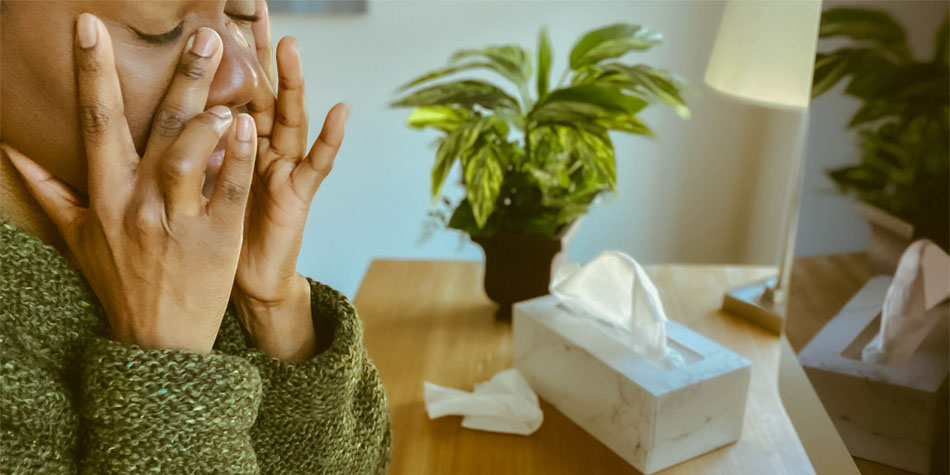
You probably don't think much about your sinuses or how to keep them clear until they get stopped up or start throbbing painfully.
Then you may wonder what's going on in these air‐filled cavities. Sinuses are a bit of an oddity because scientists have not been able to pinpoint their key role in the body.
We do know that sinuses make the skull lighter and amplify your voice, but they also affect breathing. The most noticeable thing sinuses do is produce mucus — about a quart a day! This mucus helps lubricate the inside of your nose and catch debris floating in the air, like germs, dust, pollen and pollutants. Sinuses drain mucus into the nose or throat with the help of tiny hair‐like structures called cilia, which sweep along mucus and anything caught in it.
A closer look at sinuses
People tend to refer to sinuses as a single set of openings, but you actually have four connected sets of sinuses. Experts call these cavities your paranasal sinuses because of their proximity to the nose. Here's how they break down:
- Frontal sinuses are located in your forehead, arched over your eyebrows.
- Maxillary sinuses are located behind both cheekbones.
- Ethmoid sinuses are air cells clustered in the spongy ethmoid bone, located between the eyes and nasal cavity.
- Sphenoid sinuses are behind the ethmoid sinuses in your sphenoid bone, which forms part of the eye socket.
Although sinus air cavities are small, they can cause a lot of misery. Just ask anyone who struggles with nasal allergies, sinusitis or sinus headaches.
Nasal allergies are triggered when you breathe in allergens like pollen, mold, dust or pet dander. If you have allergies, your body will respond to these particles by pumping out extra mucus to try to flush them out. At the same time, sinus tissue swells, making it hard for mucus to drain out.
Sinusitis is an infection of the body sinuses most often caused by a virus, though it can result from bacteria, too. Typically, your sinuses are empty, but colds, allergies, nasal polyps or even a deviated septum can cause sinuses to become blocked and fill with fluid — the perfect breeding ground for bacteria.
Acute sinusitis tends to develop quickly, causing cold‐like symptoms like a runny nose and facial pain. This type of infection typically clears up within about 10 days. Chronic sinusitis, on the other hand, can last much longer, sometimes up to eight weeks.
When fluid builds up in the sinuses due to allergies or infections, it can cause pain in your forehead, cheeks and sometimes behind your eyes. This can result in a very painful type of headache.
The symptoms of sinus headaches can also occur with migraines. To tell the difference between sinus headaches and migraines, pay attention to other symptoms. Migraines are more likely to trigger additional symptoms like nausea, sensitivity to light and sound, or severe throbbing on one side of the head.
Find relief from sinus problems
Over‐the‐counter decongestants and antihistamines can ease stuffy or drippy sinuses. At‐home remedies may also relieve symptoms. A few to try:
- Saline nose drops help soothe inflamed nasal passages and sinuses.
- A neti pot rinses out your sinuses and help flush away bacteria and other irritants.
- Warm compresses temporarily relieve facial pain and soften mucus inside your sinuses.
- Humidifiers add moisture to the air, which helps thin out mucus so it drains more easily.
If these treatments don't help or sinus problems won't go away, consult your physician. You may have bacterial sinusitis and need an antibiotic.
Practice prevention to avoid sinus problems
You know the old expression about an ounce of prevention. Well, it holds true for sinus problems, too.
To stay healthy, wash your hands frequently, eat a healthy diet, rest and get adequate exercise. Here are some other ways to help ward off sinus infections:
- Get an annual flu vaccination.
- Run a humidifier to keep the air from getting too dry, which can irritate sinuses. (If you're allergic to humidity‐loving dust mites or mold, skip the humidifier.)
- Avoid antibiotics unless you really need them. Sinus inflammation caused by colds or allergies won't respond to antibiotic treatment.
- Quit smoking.
- Use nasal irrigation to keep mucus draining.
While these strategies may help reduce your risk, sinus issues can prove hard to avoid for some people. Remember: It's important not to let sinus problems linger too long. If you experience symptoms for two weeks or more, talk to your doctor.
$webqFacilityNumber
Need a Physician?